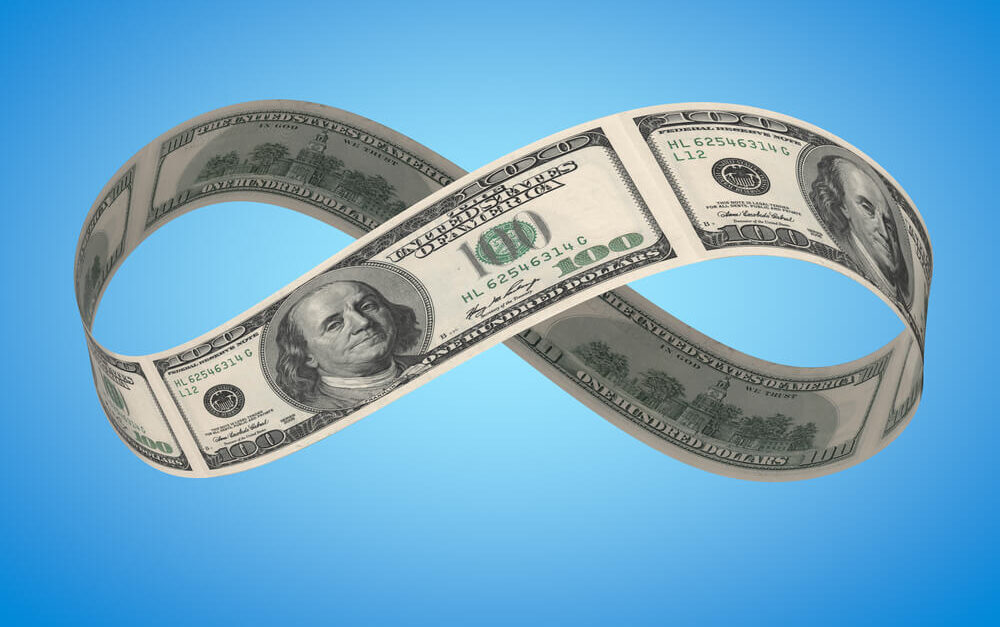I’ve made no secret of the fact that I think the U.S. stock market is pricey.
And it’s only gotten pricier over the past five months.
Outside of the 1990s tech bubble, this is the most expensive the S&P 500 has ever been as measured by the cyclically-adjusted price/earnings (CAPE) ratio.
But valuation is a nebulous concept these days. And based on the pricing methods taught in every business school and used by almost every Wall Street analyst, you could make an argument that the correct price for a stock today is infinity.
I know, I know. Nothing can be worth “infinity dollars.” But in a world of zero interest rates, pricing models spit out numbers like that.
This gets a little wonky, but let me walk you through it.
How Wall Street Models Work
Most analysts use a “discounted cash flow model” to value stocks. That’s not as complicated as it sounds.
The fundamental idea is that a dollar tomorrow is worth less than a dollar today. It has to be “discounted” to give you a value in today’s dollars.
This is how the models work. First, you come up with an estimate for earnings, dividends, cash flows or any metric you want to use.
For our purposes today, we’ll just say “cash flows.” You forecast cash flows into the future, reduce them using your discount rate and then add them up to get the “correct” value for the stock.
Here’s an example.
Let’s say you think Apple will have free cash flow per share of $20 next year. And we’ll use a 7% discount rate. (I’ll show you where that number comes from later.)
Here’s the math:
$20 ÷ (1 + 0.07) = $18.69
Next year’s $20 cash flows are worth $18.69 today.
Now, let’s say you think Apple will have free cash flows of $25 two years from now. You have to discount it by two years:
$25 ÷ (1 + 0.07) × (1 + 0.07) = $21.93
That works out to $21.93 in today’s dollars.
You do this for as many years as you can forecast, and then add a “terminal value” to the end. Add it all up, and you get your “correct” stock price.
But how does this lead to the “infinity dollars” situation?
How to Get to “Infinity Dollars”
The discount rate is the company’s cost of capital (weighed by debt and equity). I’ll skip a few steps and give you GuruFocus’s estimate of Apple’s cost of capital at 7.1%.
Now in a world where the Federal Reserve backstops everything, that number is far too high. Perhaps the “real” discount rate should be 5%. Or 2%. Or, for that matter, 0%. The lower risk something is perceived, the lower the discount rate.
And here’s where this matters.
After calculating the discounted cash flows for a couple of years, you have to calculate a “terminal value” for the stock.
I won’t bombard you with math, but this is it in a nutshell. You divide your estimate of future cash flows by your discount rate minus your expected long-term growth rate.
If your discount rate is 7% and your expected long-term growth rate is 7%, then you are dividing by zero (0.07 – 0.07) … which gives you an expected value of infinity.
Again, Apple can’t be worth infinity dollars. For that matter, the entire stock market can’t be worth infinity dollars. These are nonsense numbers.
But this is the problem. In an interest-rate environment like this, values no longer have meaning. It’s all nonsense.
What Low Interest Rates Mean for Stock Value
If you’re looking to short this market based on valuation … don’t.
Yes, the market “feels” expensive. But without a good way to calculate it, how can you say it’s expensive? Expensive relative to what?
With nothing to tether value to, it makes a lot more sense to be a trader in this market rather than an investor. Keep your horizon short-term, and take it day by day.
P.S. Money & Markets Chief Investment Strategist Adam O’Dell has spent eight years perfecting a short-term trading strategy that targets market-beating stocks in any trading environment.
Money & Markets contributor Charles Sizemore specializes in income and retirement topics. Charles is a regular on The Bull & The Bear podcast. He is also a frequent guest on CNBC, Bloomberg and Fox Business.
Follow Charles on Twitter @CharlesSizemore.
